How to Grow Beets from Seed to Harvest
This post may contain affiliate links, which means that I may receive a commission if you make a purchase using these links. As an Amazon Associate I earn from qualifying purchases.
Beets do double-duty in the kitchen, producing tasty roots for canning, roasting, or boiling, and fresh greens for salads, soups, and sautéing. Here are tips for growing beets, plus types of beets to consider adding to your vegetable garden.
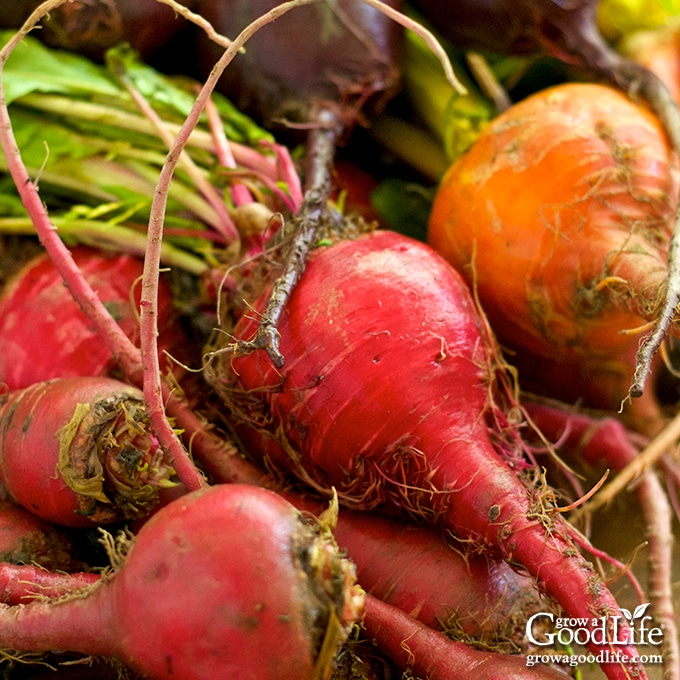
Beets (Beta vulgaris), also called beetroots, common beets, or garden beets, are a cool-season crop grown for both the roots and greens. Beets are typically red or golden in color, have a sweet and earthy flavor, and can be eaten raw or cooked.
The roots can be cooked by roasting or boiling and used in salads, soups, stews, or as a side dish. The beet greens can be added to salads if harvested as baby greens, or cooked like spinach. Beetroots are a good source of riboflavin as well as folate, manganese, and the antioxidant betaine, while the greens are a source of riboflavin, iron, and vitamins A, C, and K.
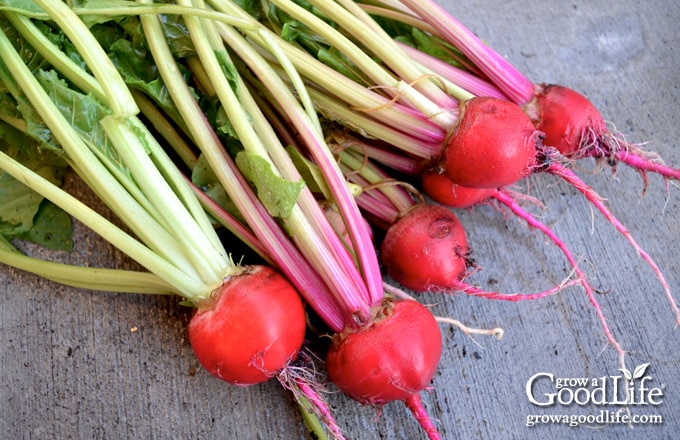
Honestly, it took a while until I actually liked beets. The first time I tried homegrown beets I wasn’t impressed. They were fibrous and tasted like dirt to me.
I was pretty disappointed since I had purchased a bunch of beet seeds that year. I decided to continue planting the seeds anyway for their greens, which taste similar to Swiss card and spinach.
I didn’t give up on beetroots though. When I tried them again, I was pleasantly surprised to discover that younger beets do not have the same texture and taste as older ones. Instead, they have a sweet, slightly earthy flavor. Not the dirt flavor I tasted previously.
As I explored growing and tasting different types of beets, I found that some varieties are much milder in flavor, and that most need to be harvested small, or they turned fibrous, woody, and had a stronger earthy flavor.
Types of Beets to Consider Growing
There are so many types of beets. All are pretty easy to grow, and tend to mature between 50 to 65 days.
When we picture beets, most of us think of the typical ruby-red beets that are found at the supermarket. While there are a number of red beet varieties, there are also other colors that range from the classic deep red, to reddish-purple, gold, light yellow, white, and even banded with candy stripe scarlet and white rings.
You’ll get the strongest beet flavor from the red varieties, but the yellow and white are less intense. Gold beets have a softer earthy flavor and white beets even less so.
White beets also do not have the betalain pigment, which gives the red and yellow beets their earthy flavor as well as their color. Bonus is, both gold and white beets don’t bleed like the classic ruby red beets.
Here are some of the most common varieties of beets to consider growing in your vegetable garden:
Red Beet Varieties
Red beets are the classic beets — dark red, earthy, and strong beet flavor. Red beets also ooze their scarlet liquid when cut and cooked. For many, nothing but the old-fashioned beet flavor and color will do. Here are a few red beet varieties to consider:
- Detroit Dark Red Beets: A popular deep red, round beet variety that grows up to 3-inches in diameter. It matures 50 to 60 days but can be enjoyed as baby beets as soon as the roots form. Enjoy both roots and greens. Detroit dark red grows well in a wide range of soil and temperature conditions. Purchase Detroit Dark Red Beet seeds.
- Early Wonder Tall Top Beets: A quick maturing deep red beet that grows rapidly in cool soils, maturing in just 45 days. It produces globe shaped roots up to 2 to 3 inches. The taproot is small making this beet a great choice for growing in containers. The greens are tall red stalks with deeply red-veined glossy green foliage. Purchase Early Wonder Beets.
- Boro Beets: A smooth, dark-red beet that grows uniform round baby beets ready to harvest in 50 days. If left to mature longer, roots can grow up to 6-inches in diameter without turning woody. Boro is a great beet variety for winter food storage. Purchase Boro Beets.
- Ruby Queen Beets: A deep red, round shaped, and sweet beet variety, with short green tops. It fully matures in 50 to 60 days, but can be enjoyed as baby beets as soon as the roots form. Ruby Queen grows well in most soil types.
- Cylindra Beets: Also known as Forono and Formanova. These beets mature in about 55 days. These beets grow smooth cylindrical shaped roots that are 1 to 2-inches wide and 6-inches long. The long shape makes it easy to slice evenly for canning and baking beet chips. Buy Cylindra Beet seeds.
Stripped Beet Varieties
- Chioggia Beets: Chioggia, also known as Bassano, candy stripe, candy cane beet, and bulls-eye beet, is an Italian heirloom with pretty red and white stripes. It has a mellow sweet beet flavor, and works well for roasting, pickling, or eating raw. Enjoy both the roots and greens. It matures in about 55 days.
- Chioggia Guardsmark Beets: An improved strain of Chioggia beets that has been bred to produce uniform sized beets, with a flattened round root shape, and the classic pink-and-white bulls eye interior. The flesh is very tender, mild, and slightly sweet. Buy Chioggia Guardsmark beet seeds.
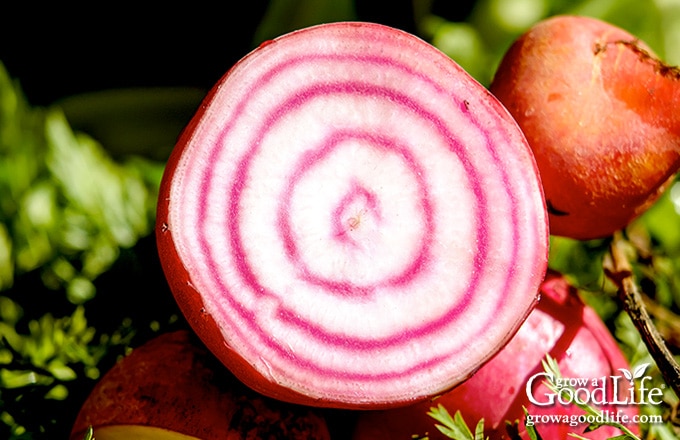
Gold Beet Varieties
Gold beets have a milder earthy flavor. The big bonus with golden beets is they do not bleed when sliced and cooked.
- Boldor Beets: The flesh is rose-gold, but changes to light orange when cooked. It has a mild, sweetness and beet flavor. Boldor is known for good germination and quick growth even in less than ideal growing conditions. It fully matures in about 55 days. The greens are short light green with gold stems and veins.
- Golden Boy Beets: Another mild flavored beet that doesn’t stain like the red beets do. The flesh is golden-orange colored, and the edible leaves are bright green. Harvest beet greens, young baby beets, or fully mature beets in 65 days. Purchase Golden Boy Beet Seeds.
- Touchstone Gold Beets: Bright orange skin with golden interior. Forms uniformly round roots with deep green, yellow-veined tops. Flavor is mildly beety. Harvest beet greens, baby beets, or fully mature beets in about 55 days. Buy Touchstone Gold Beets.
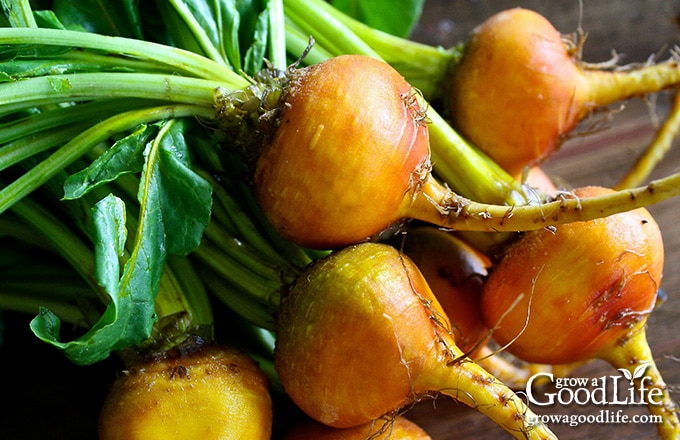
White Beet Varieties
White beets do not have the betalain pigment that gives the red and yellow beets their earthy flavor as well as their color. So white beets have an even milder flavor than the red and gold varieties, and won’t bleed like the classic ruby-red beets.
- Avalanche Beets: A creamy white, sweet beet with a mild flavor. The round roots mature in about 50 days. White beets combine well with other vegetables without staining. Harvest beet roots small, 1- to 3-inches for more tender beets. Purchase Avalanche beet seeds.
- Blankoma Beets: Similar to Avalanche with white flesh and sweet, mild flavor making them ideal for salads, soups, and pickling. Harvest early for mild, baby beets, within 55 days. Blankoma beets are best enjoyed small, 1- to 3-inches. If allowed to grow too large the texture can become tough and fibrous.
- White Albino Beets: Plant produces high yields of sweet white beets with excellent flavor. White Albino beets can grow quite large without becoming bitter. Good for roasting, pickling, boiling, and freezing, but doesn’t hold up to pressure canning very well.
Tips for Growing Beets
Beets are a versatile vegetable that can grow in many different climates and soil types. The plants don’t need special treatment, and are rarely bothered by pests.
Beets will grow in full sun, and also do well in partial shade. Since they mature quickly, within 6 to 8 weeks, beets are an ideal crop for succession planting. Sow a hand full of seeds and thin the plants in a few weeks. Add the thinned greens to your salads. Here are tips for growing beets:
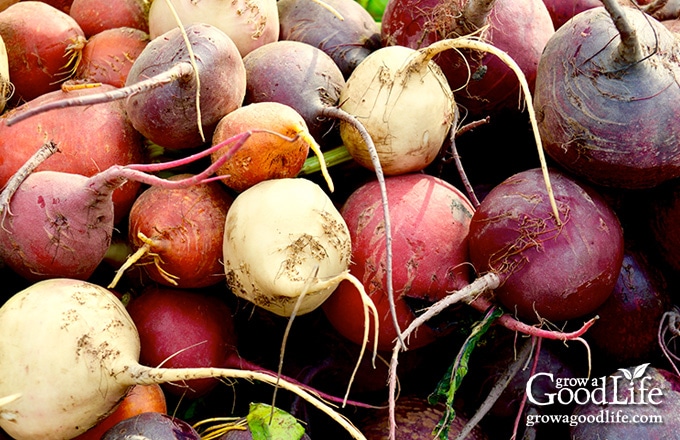
When to Grow Beets
Beets prefer cooler weather can tolerate some light frosts. Plan to grow beets during the cool gardening seasons of spring and fall. If your winters are mild, you can grow beets during the winter too.
The time to start your seeds will depend on your last frost date. This is the average date of the last expected frost date for your area. You can find your last frost date by contacting your local extension office or enter your zip code here at PlantMaps.com.
Start early spring sowings once the ground can be worked, and the soil has warmed to 40˚F. Sow fall beets in late summer once the temperatures begin to cool below 85˚F, and up to 3 weeks before your estimated first frost date.
Prepare Your Growing Beds
Beets develop best in loose, well-drained soil, with a soil pH around 6.5. However, they will tolerate a wide range of soil conditions and textures.
Before sowing your seeds, prepare your garden beds by removing weeds and loosening the soil deeply with a digging fork. Eliminate any large clumps and rocks, and enrich the soil with some mature compost, and a balanced organic fertilizer.
If the weather has been dry, prepare the growing bed, and water very well the day before you sow.
Sowing Beet Seeds
Direct sowing outside in the garden is the best way to start beet seeds. Since beets have a long taproot, they don’t transplant very well.
Seeds can benefit from a brief soaking in water for several hours before planting to soften the seed coat. Poke holes or dig a furrow about 1/2 inch deep, space the seed out 2 to 3 inches apart, and cover with soil. Firm the soil gently, and water in well. Also see How to Direct Sow Seeds for tips for planting seeds in the garden.
Seeds can take between 10 to 20 days to emerge from the soil. They will germinate quicker in warmer soil between 55 to 75˚F, but will not germinate above 85˚F.
Keep the Soil Evenly Moist
Water well at planting time, and maintain a damp soil until the seedlings become established. Don’t allow the soil to become waterlogged or the seeds will rot. When the beet plants begin to grow, let the soil dry slightly between watering.
Water deeply and regularly during dry periods. Water stress during the first 6 weeks of growth often leads to bolting, or premature flowering, and low yields. Moisture fluctuations can slow growth, and trigger the roots to crack and split.
Thin Your Beet Seedlings
Beets will grow small roots, or may not form roots at all if they are overcrowded. Generously thin and keep young seedlings well weeded throughout the growing period.
Beet seeds are actually a seedpod that contains several seeds that will sprout and grow close together. Eventually, you will need to thin out the seed clusters so the roots have plenty of room to expand.
When the beet tops reach about 5-inches high, thin the seedlings to one plant every 3 to 6 inches. Toss the thinned greens in salads with your other greens. Pull out discard weeds as you thin the beets.
Mulch the Soil
Once the beet seedlings become established, add a layer of mulch on the soil surface to help hold in soil moisture, keep the soil cool, and help suppress weeds. Keep the mulch a few inches away from the stems of your seedlings so it doesn’t smother the plants. A variety of materials can be used as mulch, including straw, shredded leaves, or pine needles. Learn more about How to Use Mulch in Your Vegetable Garden.
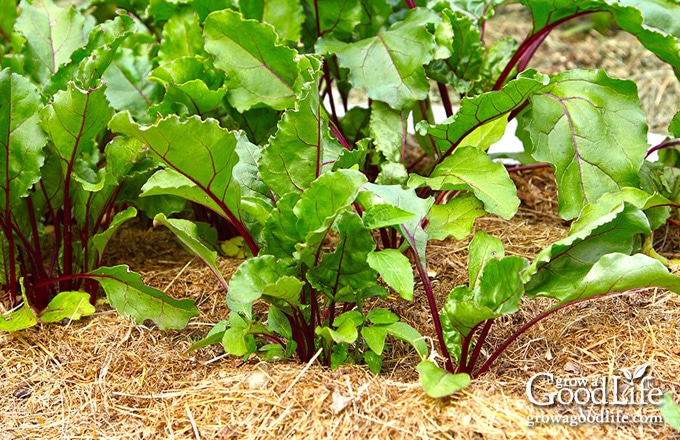
Thin Your Beet Seedlings
When the beets are about 5-inches high, thin to one plant every 3-6 inches. Toss the thinned greens in salads with your other greens. Pull out discard weeds as you thin the beets. Beets will grow small roots if they are crowded. Generously thin and keep young seedlings well weeded.
Succession Sow Beets
Sow seeds every 3 weeks for a continuous harvest until the weather warms. Seeds will not germinate in temperatures above 80˚F, so stop spring sowings once the summer heat begins to build.
Begin sowing beets again in late summer for fall harvests once the weather cools, and succession sow every 3 weeks up to the last expected frost date in your area. Learn more about succession planting: 3 Succession Tips to Maximize Your Harvest.
Extend Your Beet Harvest
Established beets can tolerate frost to about 30˚F without harming the greens. Simply cover with hoops and row covers to prevent the foliage from becoming frost damaged as the weather cools in the fall. Harvest beetroots before the temperatures drop to 20˚F. Also see How to Protect Plants from Frost.
When to Harvest Your Beets
Beets can be picked at different stages of growth, depending on what you plan to use them for. Baby beets are tender, and have a mild flavor, making them perfect for tossing in salads, eating raw on a veggie platter, or preserved by canning.
Mature beets are earthier in flavor and are best cooked by boiling or roasting. Well-developed beets also hold up well when preserved by canning, pickling, or storing in a root cellar.
Pick beet greens when they are 5-inches tall. You can snip a stalk or two from each beet plant without compromising the root growth. Harvest the beetroot when it is 2 to 3-inches in diameter. Larger beets can become fibrous and woody.
Harvest beets on a dry day in the morning while the ground is still cool. To avoid damaging the greens, use a digging fork to loosen the soil under the roots, and then gently pull the beets out of the ground by the roots.
The greens will continue to sap moisture from the roots after harvesting, so it is best to remove them right away. Separate the roots from the tops, leaving about 1 inch of stem attached.
Rinse the roots and greens very well under clean running water, and let air dry on a kitchen towel. Store roots and greens separately in the refrigerator for about a week, or preserve beets for later. Try using the greens in this Sautéed Beet Greens Recipe and roasting the roots in this Rustic Roasted Rood Veggies Recipe.
Troubleshooting Pests, Diseases and Nutrition
Beets are pretty easy to grow and rarely have problems, but here are a few issues you many come across.
- Insects: Aphids, flea beetles, leaf miners, caterpillars, slugs, grasshoppers, and other insects may munch on the foliage. These usually resolve themselves over time. Cover plants with a floating row cover to protect them from insects. Cut and destroy affected foliage. Control weeds to keep the population down.
- Diseases: Cercospera leaf spot, scab, and root rot are the most common diseases affecting beets. These usually explode in high moisture conditions. Increase airflow, thin plants to prevent overcrowding, weed frequently, and water early in the day so the foliage can dry.
- Nutrition Deficiencies: If you prepared the garden beds before planting, it should have the proper nutrition to grow healthy plants. However, nutrient deficiencies may occur. If your beets have lots of healthy greens, but no roots, this is a telltale sign of too much nitrogen. If beets have black cankers in the roots, soil may need more boron. Add fertilizer as needed to balance what is missing.
How to Grow Beets in Containers
Beets grow very well in containers, and will provide plenty of baby beets and greens. Choose a pot that is at least 12 inches deep and 12 inches wide, with drainage.
Choose a good quality potting mix suitable for growing vegetables in containers. It will need to be a smooth soil to grow beets. Sift the soil first if your mix includes stones, chunks, or wood chips. Add a balanced slow release organic fertilizer, mix it in well to distribute, and then hydrate the soil by letting it soak for several hours. Fill the pot once the soil is evenly damp.
Plant the seeds 1/2 inch deep, 2 inches apart, cover with soil, firm in gently, and water in well. Keep the soil evenly moist until the plants become established. Then let the soil dry out a bit in between, watering only when the top inch of soil is dry.
Once the greens are about 5 inches tall, thin the plants so they are spaced to one plant every 3 inches. A feeding every 2 weeks with a balanced organic liquid fertilizer such as fish and seaweed emulsion will keep your plants nourished. Harvest beets and greens once the reach a usable size, and sow more seeds every 2 weeks.
Growing Beets Indoors
If you want to have fresh beets all winter, or if you don’t have growing space outdoors, try growing beets indoors in containers under lights. Growing beets indoors will provide you with delicious beet greens and delicate baby beets.
While beetroots grow best with plenty of light, you may be able to get a good harvest of beet greens growing in natural light from a south-facing window.
A medium sized container that is about 12-inches wide and 12 inches deep will grow about beet 8 plants. Fill the pot with a damp potting mix suitable for containers. Mix in a balanced slow release organic fertilizer, and plant the seeds 1/2 inch deep. Water the plants regularly, thin as needed, and wait until the beets are big enough to harvest.
Harvest beet greens by clipping a few greens from the outer edge of each plant, and allow the plant to continue growing. Pull young baby beets as needed.
Preserving Beets
Beets will last for 2 to 3 weeks when stored in the refrigerator. Cut off the leaves, leaving about 1-inch of the stem, and store loose in your refrigerator’s crisper drawer, or in an open zipper bag. Here are several ways to preserve beets longer.
Storing Beets
For winter storage, allow beets to stay in the ground for a few rounds of mild frosts, but harvest before a hard freeze. Harvest, trim greens and tap root to 1-inch. Brush off the loose soil, but do not wash. Store only good-quality roots without any bruising, splits, or damage.
Store beetroots in buckets, boxes, or totes packed with damp sand or sawdust. Ideal storage condition for beets is at a temperature of 32 to 35˚F and 90% relative humidity. Check sand or sawdust frequently and re-moisten as needed to keep it damp. Beets can last up to 5 months in storage.
Canning Beets
If you are canning beets, harvest within a few days of your canning project so the beets are fresh. Separate the beets and greens and store in the refrigerator until you are ready to can them. Follow this article How to Can Beets using a pressure canner.
Freezing Beets
Beets can also be frozen, but the root doesn’t maintain its firmness. So it is best to use frozen beets in recipes where they will be pureed, such as smoothies, dips, and soups.
Trim the beet greens leaving about one inch of stem to help prevent bleeding. Wash the roots well, and sort by size. Bring a large pot of water to boil over high heat, and fill a large bowl with cold ice water.
Blanch the beets by cooking in boiling water until they are soft enough to pierce easily with a fork, about 30 minutes for small beets, and 45 minutes for medium sized beets. Then plunge the beets in the bowl of ice water to cool quickly. Peel, remove the stems, taproots, and cut into slices or cubes. Package into freezer bags, remove air, and store in the freezer for up to 12 months.
—
Beets are a versatile vegetable that can be used in a variety of dishes. They are easy to grow and can be harvested at different stages depending on the meals you are preparing. So, if you are looking for a new vegetable to add to your vegetable garden, consider planting beets.
Resources and Further Reading
- Beets – University of Maryland Extension
- Discover the History of Beets – PBS.org
- Types of Beets – Berkeley Wellness
You May Also Like:
- How to Grow Beets Indoors
- Tips for Growing Beets in Partial Shade
- How to Store Beets for Winter Food Storage
- Tips for Direct Sowing Beet Seeds
Good planning is key to a successful vegetable garden
Whether you are new to growing your own food or have been growing a vegetable garden for years, you will benefit from some planning each year. You will find everything you need to organize and plan your vegetable garden in my PDF eBook, Grow a Good Life Guide to Planning Your Vegetable Garden.


I love growing beets. Unfortunately, the deer love them just as much and we rarely end up with any to eat.
Phoelisa, We battle with deer every year too. Hoops and netting can help protect your beets and other greens from hungry deer.
Hello
My name is Marie
I planted beets and they grown lots of leaves and very small fruit. Do you have any idea what happened?
Please let me know so I can fix it next time.
Thanks
Marie
Marie, There could be a lot of reasons why your beets didn’t grow roots, including lack of nutrients, moisture, and overcrowding. What are your growing conditions? Does the garden bed get enough sun?